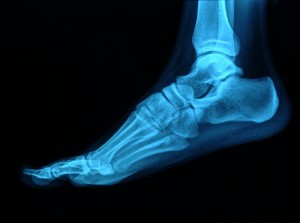Symptoms Of A Broken Foot or Symptoms of a Sprained Foot?
Is My Foot Broken or Sprained?
You are having a great time, playing a fun game of football and then boom, you land on your foot wrong and it’s facing the wrong direction—now what?! Are they symptoms of a broken foot or of a sprained foot? Considering 25% of the total bones in our body are located in our feet (this includes 26 bones per foot, 100+ muscles, and 33 joints) there are a number of injuries feet can sustain. Our complex set of feet take on the hefty job of carrying us around and bearing our weight everyday, and so it’s not all that surprising that foot injuries continuously increase almost every year, and 25,000 foot and ankle injuries are reported daily.
Pre-existing  medical conditions can increase the likelihood of injury, children are more prone to foot injuries because their bones are not as strong as they will grow to be, the same amount of force that will only sprain an adult’s foot can be enough to break a child’s more delicate foot. If foot pain has started to bother you it’s important to identify the type of injury you have. 2 common foot injuries are broken feet and sprained feet, each has a different course of treatment and period of recovery. Common Foot Injuries.
medical conditions can increase the likelihood of injury, children are more prone to foot injuries because their bones are not as strong as they will grow to be, the same amount of force that will only sprain an adult’s foot can be enough to break a child’s more delicate foot. If foot pain has started to bother you it’s important to identify the type of injury you have. 2 common foot injuries are broken feet and sprained feet, each has a different course of treatment and period of recovery. Common Foot Injuries.
All About Foot Sprains
When a foot is sprained it is not the bones affected, but instead the pain comes from the connective tissues between the bones and joints stretching or tearing. There are varying levels of sprains, some less severe than others. Grade 1 sprains are considered mild injuries that involve small tears or stretches of the ligaments. Grade 2 sprains identify partial tearing or stretching of ligaments, and the most severe Grade 3 sprains involve ligaments tearing completely from the bone. Find Out More!
Signs of a Sprained Foot Include:
- Painful swelling
- Bruising on your feet
- Inability to bear weight (this is a sign of a severe sprain)
If you are unable to stand on your foot further exams, such as an x-ray, may be required to ensure your foot is not instead broken. For less severe sprains the pain should subside within a few days, in the instance it does not you should consult with your doctor. If you ignore these sorts of injuries they will only get worse and create more problems in the future.
Treatment Options for a Sprained Foot:
- Plenty of rest and stay off of the injury
- Use ice to bring down any swelling
- Keep your injured foot elevated and tie an elastic bandage around to compress the swelling
- Pain medication might be prescribed to help ease the pain
Additional Treatment Options for Sprained Feet.
All About Broken Feet
Everyone would prefer a sprained foot to a broken foot, as the time to heal and level of pain involved increases severally with a broken foot. Some patients will continuously try standing on their foot to determine if it is broken, this is not recommended and can actually make the break much worse. The quickest way to find relief is to seek medical attention instantly.
Common Symptoms of a Broken Foot Include:
- Painful swelling
- Inability to move or stand on your foot
- Bruising
- Foot bent at an unnatural angle—such as facing the wrong way
- Pain that increases when your foot is under pressure
Symptoms of a broken foot and of a sprained foot are noticeably similar, although a broken foot is going to cause a lot more pain than a sprained foot. Also, bruising and swelling is going to increase with a break as well. Still, an x-ray is one of the only ways to know for sure. Discover more symptoms of a broken foot HERE.
Treatment Options for a Broken Foot:
In the instance that your foot is broken it is not always an easy road to recovery, breaks can happen at multiple points of your foot, and vary tremendously in severity. Some broken feet require a walking boot, others require a cast or crutches, and in more severe instances a wheelchair might be necessary. For broken toes, treatment is much easier and can simply involve taping the broken toe tightly to its adjacent partner so that it grows back correctly. If you properly follow all doctor orders and don’t need additional surgery, foot injuries take on average about 6-8 weeks to mend.
When To Visit Your Doctor For Foot Pain
Since our feet absorb so much impact everyday it’s not uncommon for sore spots to surface, although if a sudden injury arises or persistent pain persists you should visit your doctor or an urgent medical center.
Signs Your Foot Needs Medical Attention:
- Extreme pain and discomfort
- Foot turns blue or becomes cold, numb
- Visibility of a bone coming through the skin
- Foot is in an unnatural position, such as turned the wrong way

